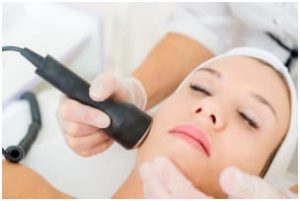When you hear the word “laser,” you might think about science fiction movies or light shows synchronized to music. In the real world, sophisticated laser technology has a wide range of applications, from military and industrial to law enforcement and health care. Lasers are a very common part of everyday life in devices such as grocery store scanners and DVD players.
The medical field has benefited from the use of lasers as well. Lasers offer safety and precision to perform delicate procedures like repairing detached retinas, removing tumors and even resurfacing skin.
Laser skin resurfacing, sometimes referred to as laser peels, is used to reduce or eliminate fine lines, wrinkles, and acne scars. While laser skin resurfacing does have its benefits, there are a number of significant downside risks to consider compared to less invasive Silk peel treatment options. It’s VERY important to know what you’re getting yourself into with laser skin resurfacing before settling on any particular treatment.
Science Behind Laser Skin Resurfacing
Laser is an acronym for “Light Amplification by Stimulated Emission of Radiation.” A surgeon or specialist uses a small but strong pulsating beam of light to cut or burn away tissue. In the case of skin resurfacing, lasers remove facial imperfections utilizing two different methods:
- Ablative lasers are considered an “invasive” procedure that essentially burns away the outer layers of skin, removing dead and damaged cells.
- Non-ablative lasers are less invasive. They provide the heat that promotes collagen production to fill in lines and wrinkles, but the skin itself remains intact.
Ablative laser resurfacing is best for those who want to see improvement quickly, who have severe facial or acne scars and who also can take time off from work to recover. With ablative resurfacing, it’s common to experience mild to severe discomfort but also accompanied by swelling, oozing and crusting of the skin. Recovery from ablative laser resurfacing takes a minimum of two weeks, but there is almost no downtime with non-ablative treatments. Results from ablative treatments can last up to a year, but non-ablative treatments will require a number of treatments before seeing any results from the procedure.
Results and Aftercare
Results can vary slightly from one person to another, but post-treatment you can expect to see redness similar to sunburn. There may be some minor swelling, along with itching or a slight stinging sensation, for about five days. It’s important to cleanse the treated area four to five times a day, using instructions given by your skin care specialist. You will also need to apply a salve or ointment to keep scabs from developing. After about a week to 10 days, your skin will become dry and start peeling. Your complexion will remain flushed or pink for up to two or three months after the treatment as well.
Risks of Laser Skin Resurfacing
- A very real possibility of burning or blistering due to the heat of the laser.
- After the treatment, your skin will be extremely sun-sensitive. Avoid direct sunlight during recovery, and be sure to use a high-SPF sunscreen after healing up from the treatment.
- If you suffer from acne, it can be aggravated by irritation from any laser resurfacing treatment.
- Can also trigger an outbreak of cold sores, especially if you are treated around the mouth area. If you have a history of cold sores, your doctor may prescribe a course of anti-viral medication both before and after the procedure.
- There’s also a risk of bacterial infection, which is why it’s so important to keep the affected area clean.
- Light from the laser is absorbed by pigment in the skin, and the resulting heat is what destroys the cells, while surrounding cells absorb excess light. For people with darker skin from a greater amount of pigmentation, the result can be hyperpigmentation, or further darkening and discoloration.
What Do These Procedures Cost?
According to the American Society of Plastic Surgeons, the average cost of ablative skin resurfacing is $2,146, while non-ablative runs about $1,062. Fees vary due to factors such as the expertise of the specialist and the geographic location of the facility. Additionally, laser skin resurfacing is considered cosmetic surgery, so it’s not covered by most insurance plans unless the procedure is required for health reasons.
While more than half a million people undergo laser skin resurfacing each year, the procedure does have significant risks whether it’s ablative or non-ablative. As always, talk to your dermatologist or skin care specialist about the right skin resurfacing option that will be right for you.

